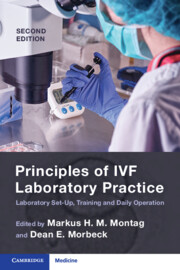Book contents
- Principles of IVF Laboratory Practice
- Principles of IVF Laboratory Practice
- Copyright page
- Contents
- Contributors
- Foreword
- The Evolution of IVF Practice
- Section 1 Starting a New Laboratory and Training Protocols
- Section 2 Pre-procedure Protocols
- Section 3 Gametes
- Section 4 Insemination/ICSI
- Section 5 Fertilization Assessment
- Section 6 Embryo Assessment: Morphology and Beyond
- Section 7 Embryo Cryopreservation
- Chapter 35 Zygote Cryopreservation for IVF
- Chapter 36 Cryopreservation of Pre-compaction Embryos for IVF
- Chapter 37 Cryopreservation of Post-compaction Embryos for IVF
- Chapter 38 Safe and Effective Cryostorage of Embryos for IVF
- Section 8 Embryo Transfer
- Section 9 Quality Management
- Index
- References
Chapter 35 - Zygote Cryopreservation for IVF
from Section 7 - Embryo Cryopreservation
Published online by Cambridge University Press: 07 August 2023
- Principles of IVF Laboratory Practice
- Principles of IVF Laboratory Practice
- Copyright page
- Contents
- Contributors
- Foreword
- The Evolution of IVF Practice
- Section 1 Starting a New Laboratory and Training Protocols
- Section 2 Pre-procedure Protocols
- Section 3 Gametes
- Section 4 Insemination/ICSI
- Section 5 Fertilization Assessment
- Section 6 Embryo Assessment: Morphology and Beyond
- Section 7 Embryo Cryopreservation
- Chapter 35 Zygote Cryopreservation for IVF
- Chapter 36 Cryopreservation of Pre-compaction Embryos for IVF
- Chapter 37 Cryopreservation of Post-compaction Embryos for IVF
- Chapter 38 Safe and Effective Cryostorage of Embryos for IVF
- Section 8 Embryo Transfer
- Section 9 Quality Management
- Index
- References
Summary
This chapter will discuss the techniques for fertilization verification for oocytes fertilized both conventionally and by intracytoplasmic sperm injection (ICSI). The formation of the pronuclei is the first indication of the fusion of male and female gametes. Practical considerations and laboratory protocols are detailed in the chapter.
Keywords
- Type
- Chapter
- Information
- Principles of IVF Laboratory PracticeLaboratory Set-Up, Training and Daily Operation, pp. 255 - 262Publisher: Cambridge University PressPrint publication year: 2023



